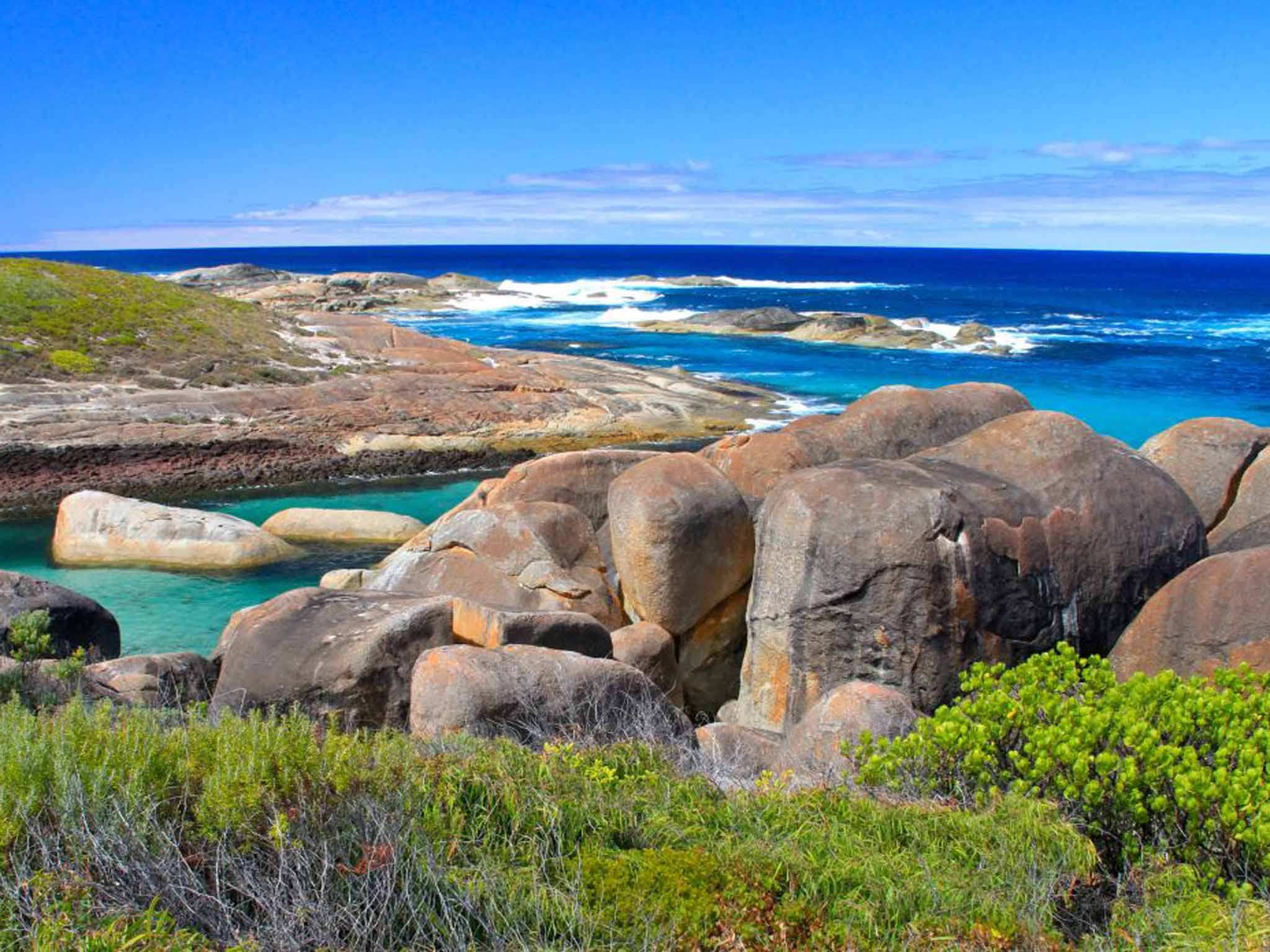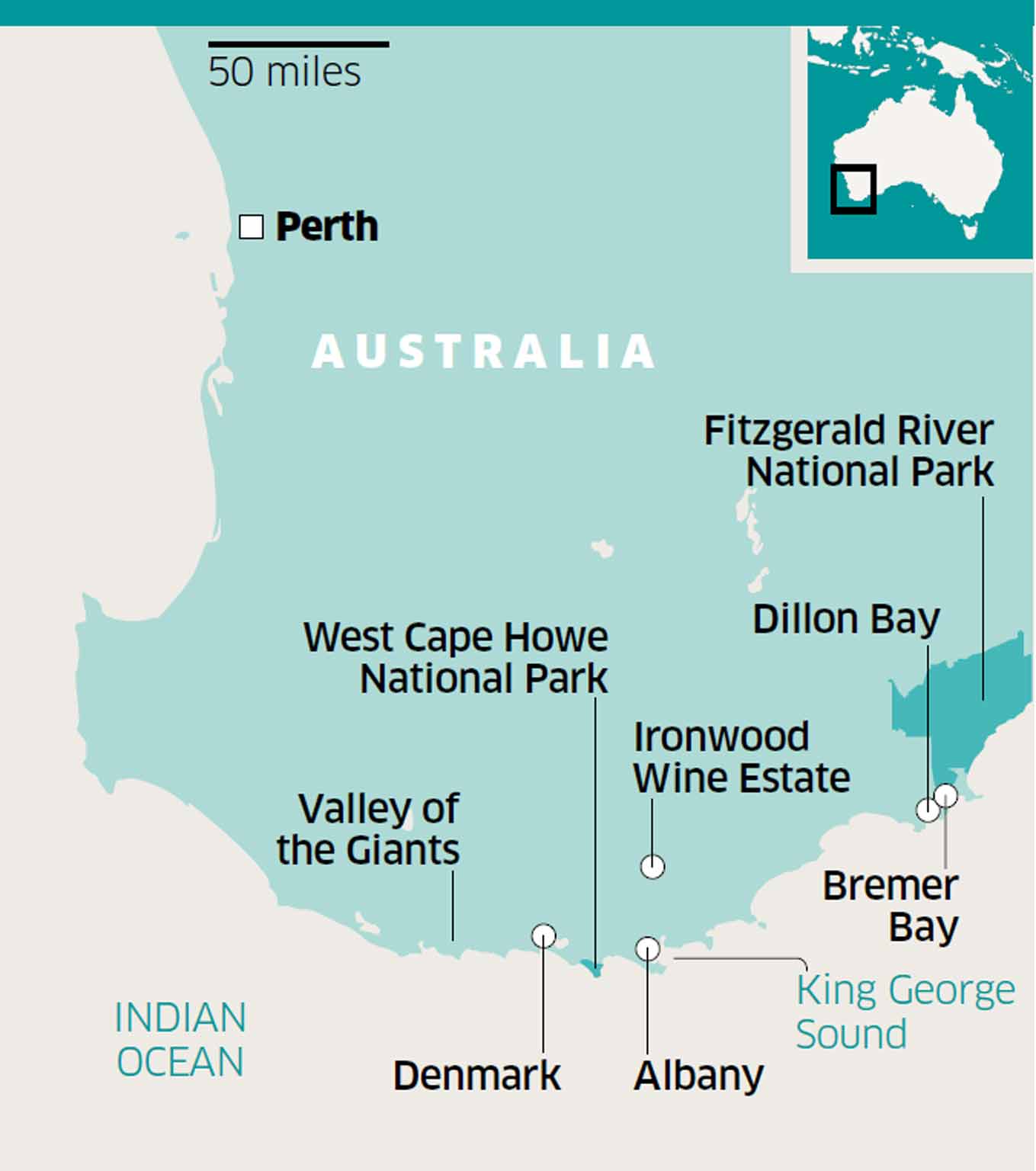The Independent's journalism is supported by our readers. When you purchase through links on our site, we may earn commission.
Western Australia's wildlife: A marine hotspot that appeared out of the blue
Off the sleepy south coast of Western Australia lies an underwater canyon where huge numbers of ocean predators converge. Mike Unwin sets off to explore

'Don't yak at the back,“ warns our skipper, Mack, reaching his net overboard. True, some faces are looking a little green as we bob in the swell, but all eyes are focused on the pale, ragged chunk of flesh that Mack drops on to the deck of the catamaran. What is it? Who's responsible? This is like some sort of maritime CSI.
It was the seabirds that alerted us: a gaggle of black-browed albatrosses squabbling over their prize while smaller shearwaters circled around. Now, our avian outriders have settled at the stern, hoping for handouts. “It's a piece of squid,” declares Mack. He points out a row of pit-like impressions. “And something's been having a chew.”
On cue, a hydraulic hiss of whale breath turns our gaze to starboard where a tall, black dorsal fin breaks the surface. Orcas! We watch as half a dozen of these squid-murdering cetaceans pass the bow, their black-and-white bodies arcing through the waves. “That's El Notcho's pod,” announces marine biologist Bec Wellard, as she recognises the big male. She's been studying the orcas all summer and knows individuals from markings and fin shapes.
This is just what I and the other 14 passengers aboard the Cetacean Explorer were hoping for when we set out from Bremer Bay an hour earlier. Western Australia has long been celebrated for its whale-watching, but until recently the whales in question have been the larger humpback and southern right species, which migrate here during winter. Orca gathering is something new – not only to tourism but also to science. It explains why Naturaliste Charters' cruises always carry a full crew of biologists.
The explanation for this startling phenomenon lies in the depths. From up here on deck, 45km south of the mainland, the ocean looks much of a muchness. But below us lies a vast 1,500m-deep fissure in the seabed, the Bremer Canyon, from which – scientists have discovered – life-giving forces well up to support a wealth of marine creatures.
For three hours we cruise up and down above the canyon. We meet three separate pods of orcas – perhaps 30 whales in total. There's no breaching or showy stuff today: the whales are hunting, moving fast and constantly diving – sometimes right beneath our boat. Meanwhile, eyes peeled, we also spy a manta ray and pass the flopping fin of a giant sunfish. Nobody knows what might show up: yesterday it was a great white shark; last week, sperm whales. “We're on the frontier right now,” explains Bec. “This really is early days for the science.”
Over dinner back at Bremer Bay Resort, marine film-maker Dave Riggs talks me through this science. “It all comes down to hydrocarbons,” he explains, describing how pressurised methane leaking from the seabed fuels nutritious bacteria to power an ecosystem that runs from shrimps and crabs at the bottom to sharks and whales at the top. It's a chemosynthetic process – similar, apparently, to the conditions in which life on Earth originated – and it makes Bremer Canyon one of the world's great marine biodiversity hotspots.

Bremer Bay seems an unlikely location for the frontier of science. This small fishing town is two hours' drive east of Albany on the southern coast of Western Australia – around the corner, as it were, from Perth – and our retreat has a cheerful road-house feel, with locals dropping by to down a beer and pick up a pizza. Kangaroo tracks criss-cross the sandy scrub below the garden, and the view down to the bay is magnificent.
Certainly it seems a long way from the urban sophistication of Perth, where, two days earlier, I was flitting between the floral splendour of King's Park Botanical Gardens and the downtown museums and cafés. But then Western Australia's south coast has been eclipsed by its west ever since the late-19th century gold rush transformed ramshackle Perth into what would become the state capital, leaving Albany – the state's founding settlement – forever in its wake.
This is fine by me. I'm in Western Australia for more rural charms, and sleepy little Bremer Bay has these in abundance. I stroll from the resort down to Wellstead Estuary, where statuesque Australian pelicans parade along a sand bar. This pretty inlet gets its name from local pioneer John Wellstead, who in the 1860s reputedly bought nearby Dillon Bay for two bags of potatoes and one of onions. The great man is celebrated at the fascinating Wellstead Heritage Museum, which is crammed with gramophones and motorcycle sidecars from another era. Above, at an elevated picnic spot on the Henry Peninsula, I enjoy a fine view of both bays – and a coastline that rolls out its beaches and headlands to the eastern and western horizons.
And it's eastwards that I travel next, towards the Fitzgerald River National Park – designated a Unesco International Biosphere for its rare fauna and flora, including endemics such as the royal hakeas that stand proud beside the track and the dense stands of banksias that turn the spring hillsides scarlet. I stroll above St Anne's Point – which in season is, reputedly, the finest whale-watching spot in Western Australia. My eyes comb the waves while a circling sea eagle casts its shadow over the deserted beach.
My bed tonight is at the Quaalup Homestead Wilderness Retreat, built in 1858 by John Wellstead (he of the potatoes and onions) and now a delightful lodge. Grey kangaroos lollop from my path as I take a sunset stroll along a nature trail, the sandstone cliffs along the river glinting gold. After a fine home-cooked supper in the old dining room, we troop outside for a spot of stargazing. Jupiter's moons are impressive but in a spangled sky it's our own Moon that steals the show, vast and pockmarked through the telescope of Carsten, my host.
Of course, Western Australia is not all nature. Returning west, I reach Albany, founded in 1827 as Fredrickstown. The town clusters around King George Sound, a glorious sweep of bay encircled with forested peninsulas and rocky islands. Locals like to champion their year-round Mediterranean climate as a gentler alternative to the blistering summers of Perth, and on this bright morning – with yachts on the horizon and swimmers breasting the surf on Middleton Beach – it is certainly appealing.

Albany is also a haven for foodies. At the Pepper and Salt restaurant, chef Silas Masih serves up barramundi and wood-fired beetroot in the spices of his native Fiji. “This sauce starts off as roasting bones on a Wednesday,” he enthuses. At the Ironwood wine estate I learn how the zesty sauvignon blancs benefit from the local mineral-rich soils. And at the Boston Brewery, brewer Tyson Addy explains how he is giving the wine estates a run for their money with such intriguing products as mango beer and coffee stout.
And to round it off? In Denmark, just west of Albany, I visit Dark Side Chocolates, where chocolatier John Wade is working with native Australian ingredients. “To me, that smells just like walking through the Bush,” he explains, offering me a rainforest pearl truffle. Perhaps, but I'm not convinced until I've also sampled the mountain pepper berry, the beetroot and shiraz, the lemon myrtle ....
Denmark leads to the last of the natural wonders on my itinerary. The Valley of the Giants, in Nornalup National Park, protects a forest of immense red tingle trees, some of which tower 70 metres over the leaf litter. An ingenious walkway extends from level ground over a steep slope, allowing us to stroll right into the canopy while hardly taking an upward step. I look out for quokkas – rare wallabies that, apparently, lurk in the sword grass below – but it all gets a bit vertiginous, and I make do with a dazzling blue fairy wren at eye level.
And so, it's back to Perth. With two months to spare, I could make this journey on foot. The Bibbulmun Track, Australia's second-longest walking trail, meanders right through the Valley of the Giants on its 1,003.1km route north from Albany to Perth. I've already tramped one gentle eight kilometre stretch through West Cape Howe National Park, amid yellow-green snotty-gobble fruit, bottlenose dolphins visible out in the surf. So, just another 995.1km to go then? It's tempting, but sadly I don't have those two months, and a day later I'm high above the Indian Ocean on my flight home, wondering what else lurks in the deep blue far below.
Getting there
Etihad Airways (0345 608 1225; etihad.com) flies daily from Heathrow to Perth via Abu Dhabi, with economy fares from £661 return. Departures from Manchester and Edinburgh are also available.
1st Class holidays (0161 888 5608; 1stclassholidays.com) has a West Coast Explorer package from £1,399pp, including Etihad flights, two nights' accommodation in Perth and 10 days' motorhome hire with Maui.
Staying there
Bremer Bay Resort (00 61 8 9837 4133; bremerbayresort.com.au). Twin rooms from A$130 (£63), room only.
Visiting there
Naturaliste Charters (00 61 8 9750 5500; whales-australia.com.au). Bremer Canyon Killer Whale Expeditions from A$350pp (£162).
More information
Join our commenting forum
Join thought-provoking conversations, follow other Independent readers and see their replies
Comments